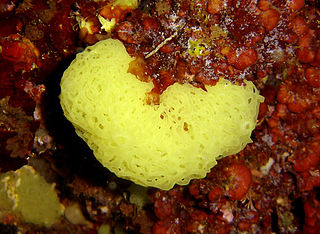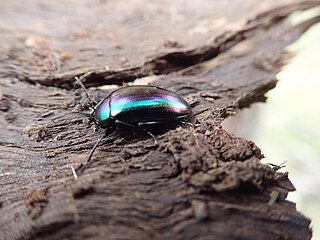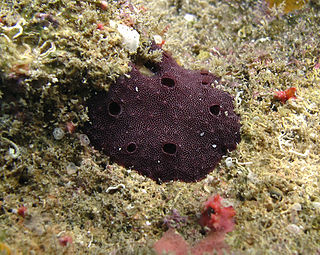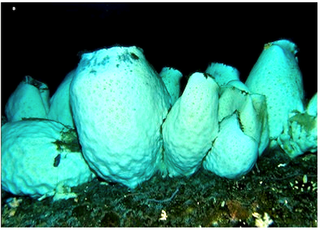
The family Psittacidae or holotropical parrots is one of three families of true parrots. It comprises the 12 species of subfamily Psittacinae and 167 of subfamily Arinae including several species that have gone extinct in recent centuries. Some of the most iconic birds in the world are represented here, such as the blue-and-yellow macaw among the New World parrots and the grey parrot among the Old World parrots.

Nothofagus, also known as the southern beeches, is a genus of 43 species of trees and shrubs native to the Southern Hemisphere in southern South America and east and southeast Australia, New Zealand, New Guinea, and New Caledonia. The species are ecological dominants in many temperate forests in these regions. Some species are reportedly naturalised in Germany and Great Britain. The genus has a rich fossil record of leaves, cupules, and pollen, with fossils extending into the late Cretaceous period and occurring in Australia, New Zealand, Antarctica, and South America.
Arda or ARDA may refer to:

Notothenioidei is one of 19 suborders of the order Perciformes. The group is found mainly in Antarctic and Subantarctic waters, with some species ranging north to southern Australia and southern South America. Notothenioids constitute approximately 90% of the fish biomass in the continental shelf waters surrounding Antarctica.

Clathrina is a genus of calcareous sponge in the family Clathrinidae. Several species formerly in Clathrina were transferred to the newly erected genera Arturia, Ernstia, Borojevia, and Brattegardia in 2013. The name is derived from the Latin word "clathratus" meaning "latticed".

Grantia is a genus of calcareous sponges belonging to the family Grantiidae. Species of the genus Grantia contain spicules and spongin fibers.

Lamiinae, commonly called flat-faced longhorns, are a subfamily of the longhorn beetle family (Cerambycidae). The subfamily includes over 750 genera, rivaled in diversity within the family only by the subfamily Cerambycinae.

Doto is a genus of sea slug, a nudibranch in the family Dotidae. This genus feeds on hydroids, as reflected by its serrated radula.

Kombuisia is a genus of dicynodont from Early to Middle Triassic of South Africa and Antarctica. Two species were described for the genus: Kombuisia frerensis (type) and Kombuisia antarctica.

Chalcopteroides is a genus of darkling beetle, defined by Embrik Strand in 1935, and replacing the older name Chalcopterus which was preoccupied. The type species is Chalcopterus iridicolor. The genus occurs throughout Australia.

Darwinellidae is a family of sponges in the order Dendroceratida.

Matoniaceae is one of the three families of ferns in the Gleicheniales order of the Polypodiopsida class. Fossil records reveal that Matoniaceae ferns were abundant during the Mesozoic era, during which they lived on every continent, including Antarctica, with eight genera and 26 species, with the oldest known specimens being from the Middle Triassic of Antarctica. Today the family is much less abundant, and also less diverse, with only two extant genera and four species, which are limited to portions of southeastern Asia.
Cinachyra antarctica is a species of antarctic sponge belonging to the family Tetillidae. It was first described by H.J. Carter in 1872. A 2002 study in Antarctica calculated that this sponge and another antarctic sponge, Anoxycalyx joubini, have amazingly long lifespans surpassing 1,550 years in C. antarctica and 15,000 years in A. joubini. A. joubini lives in deeper waters than C. antarctica. Antarctic sponges have such lifespans, probably because of their surroundings, living at 100–2,000 m (330–6,560 ft) below the surface, at extremely cold temperature and constant pressure. This may slow down their growth rate and other biological processes, which has a remarkable lifespan as a result, because in a caught specimen of A. joubini did not show any growth in a span of 10 years. C. antarctica lives at the bottom, as a benthic, sessile creature. Complete specimens have large, visible pores and an overall yellowish appearance with hair-like structures covering some parts next to the pores, giving it the look of a giant virus. Caught specimens are usually incomplete and rarely measure more than 2.5–3 cm.

Antarctosuchus is an extinct genus of capitosauroid temnospondyl known from the Middle Triassic upper Fremouw Formation in the Transantarctic Mountains of Antarctica. It contains a single species, Antarctosuchus polyodon.

Rossellidae is a family of glass sponges belonging to the order Lyssacinosa. The family has a cosmopolitan distribution and is found at a large range of depths.

Leucetta is a genus of sponges in the family Leucettidae, which was first described in 1872 by Ernst Haeckel. The type species is Leucetta primigenia Haeckel, 1872 by subsequent designation.

Rosella is a genus of glass sponges in the family Rossellidae. It is found in the Antarctic and sub-Antarctic regions.

The giant volcano sponge is a species of Antarctic sponge. It is one of the largest sponge in the world which can grow up to a diameter of 1.5 metres and 1.95 metres in height. The species may have an extremely long lifespan, with estimates of up to 15,000 years. A. joubini occurs in deeper waters than the similar species Cinachyra antarctica, which is also very long-lived. Antarctic sponges live at 100–2,000 m (330–6,560 ft) below the surface, in extremely cold temperatures and constant pressure. This may slow down their growth rate and other biological processes because one caught specimen of A. joubini, did not show any growth in a span of 10 years.
Notiolofos is an extinct genus of sparnotheriodontid ungulate from the order Litopterna. The animal lived during the Eocene, in modern-day Antarctica. The genus contains two species, N. arquinotiensis, the type species, and N. regueroi.
















